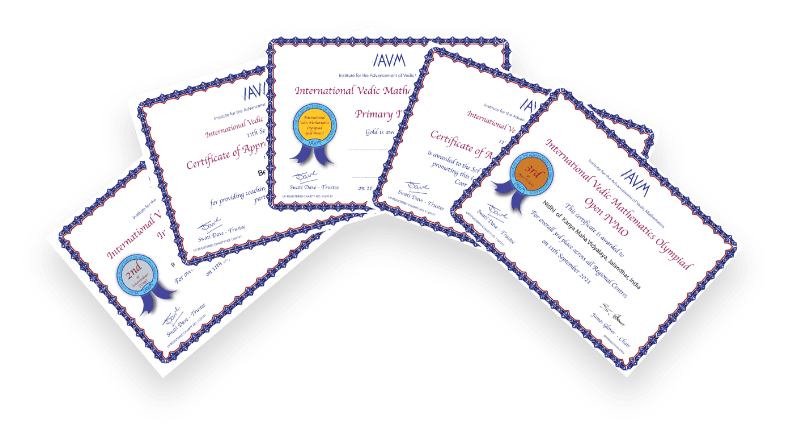FOR PARTICIPANTS
International Vedic Mathematics Olympiad
IVMO 2025
Are you a school/college/institution or an individual planning to host the IVMO Olympiad?
Registration Closed Registrations will open in 2025
Registration Fee Fee$5 (Pay only to the Centre Coordinator)


Enhances Speed

Develops Strategic Thinking

Improves Creative Thinking
Vedic learners solve mathematical calculations in double-quick time

How fast you can solve this?
846 x 997
Your time
00:00
Syllabus Coverage
The lists are accumulative. At each level topics from previous levels are included. For example, for Intermediate level, all topics in Primary and Junior are relevant

LOWER PRIMARY AND UPPER PRIMARY
9 & 11 Years & Under
- Four rules of number + – x ÷
- Four rules of simple fractions + – x ÷
- *Four rules of decimals + – x ÷
- Divisibility by 2, 4, 8, 5, 10, 3, 6, 9
- Digital roots and division by 9
- Multiplication and division by 5, 25, 50
- Nikhilam multiplication
- Squaring two-digit numbers ending in 5
- Multiplication of the final digits add to 10
- Vertically and crosswise multiplication
- Patterns and sequences
- Area and perimeter of simple shapes
- *Primes, squares, and triangular numbers
- Money
- Word Problems involving all the above
- *Not included in Lower Primary

JUNIOR
13 Years & Under
- Four rules of mixed number + – x ÷
- Decimal to fraction conversions
- Squaring numbers close to a base
- Use of vinculums (bar numbers)
- Nikhilam division
- Paravartya division
- Straight division with 2-digit divisors
- Percentages
- Direct and Indirect proportion
- HCF and LCM by Vertically and crosswise
- nth term formulae for linear sequences
- Mean, median, mode
- Simple rules of indices
- Linear equations
- Area and circumference of a circle
- Angles in parallel lines and quadrilaterals
- Volume and surface area (cuboids)

INTERMEDIATE
16 Years & Under
- Converting denominators ending in 9
- Conversion of partially recurring decimals
- Straight division with 3-digit divisors
- Simultaneous equations
- Quadratic equations
- Nth term for quadratic sequences
- Completing the square
- Difference of two square
- Cubing 2-digit numbers
- Combined ratios
- Polynomial division with binomial divisors
- Polynomial multiplication
- Factor theorem
- Indices including fractional and negative
- Using last digits to check answers
- Angles in polygons
- Equation of straight lines
- Similar areas and volumes

SENIOR
18 Years & Under
- Coefficients in polynomial products
- Using first and last terms in polynomials
- Series expansions of binomials
- Applications of discriminats of quadratics
- Divisibility using Osculation
- Logs and Exponential functions
- Inverse functions
- Partial fractions
- Method of differences
- Product and Quotient rules
- Chain rule
- Pythagorean triples
- Addition and subtraction of angles
- Geometric problems involving triples
- Areas of shapes on coordinate axes
- Integration to find areas
- Equation of circles

OPEN
For Any Age Group
- Coefficients in polynomial products
- Using first and last terms in polynomials
- Series expansions of binomials
- Applications of discriminats of quadratics
- Divisibility using Osculation
- Logs and Exponential functions
- Inverse functions
- Partial fractions
- Method of differences
- Product and Quotient rules
- Chain rule
- Pythagorean triples
- Addition and subtraction of angles
- Geometric problems involving triples
- Areas of shapes on coordinate axes
- Integration to find areas
- Equation of circles

LOWER PRIMARY AND UPPER PRIMARY
9 & 11 Years & Under
-
- All from 9 and the last from 10
- Vertically and crosswise
- By one more than the one before
- By the last digits
- By addition and subtraction
- By observation

JUNIOR
13 Years & Under
- Deficiency
- Transpose and adjust
- On the flag
- By elimination and retention
- All the multipliers
- Proportionately

INTERMEDIATE
16 Years & Under
- By completion and non-completion
- Particular and general
- Products of means. Product of extremes

SENIOR
18 Years & Under
- First by the first and last by the last
- Product/sum, Sum/product
- Differential calculus
- Osculation

OPEN
For Any Age Group
- First by the first and last by the last
- Product/sum, Sum/product
- Differential calculus
- Osculation
Register as a Participants
Registration Closed
Participate & Win Certificates

Register as a participant
Pay registration fee online or offline to centre coordinator.

Connect with centre coordinator
Take the guidance/trainings offered to excel.

Participate in the Olympiad & win!
Take part in the 1hr online test and see how fast you perform!

At each level the top 60% of scores will be awarded gold, silver, and bronze certificates in the ratio 1:2:3. The top three internationally will also receive special certificates.
Frequently Asked Questions
Do I need to register online?
You should register with your Centre Coordinator after 1st September 2024. If you do not have a Centre Coordinator, then register here and we will allocate you to one according to your location and time zone. Registrations close on 31st October, 2024.
How do I enter if I don’t have a Centre Coordinator?
You can register here. We will then allocate you to a Centre Coordinator according to your location and time zone.
Is there a date by which I need to register with a Centre Coordinator?
Registrations close on 31st October 2024.
When I register on the website, do I have to pay the fee?
No, you will pay the fee to your Centre Coordinator.
How much does it cost to participate in IVMO?
The fee is $5 (except for the Philippines). Your Centre Coordinator will inform you of the equivalent amount in your national currency.
Will my email address be made public?
No. All personal information will remain confidential. Under safeguarding and data protection regulations IAVM will not share any personal information except with your Centre Coordinator. The only exception to this is, with permission, we will publish on our website the names and photos of the top three scorers in each of the categories.
How long is the Olympiad?
The IVMO is one hour long and consists of 40 multiple choice questions
Can I sit IVMO at any time on 30th November?
No, you can only sit the test at the time arranged by your IVMO Centre Coordinator
Can I get a list of topics?
Yes, they are available here.
Can I see past papers or sample papers?
Yes, these are available for download here.
If taking online, will I be able to go back and change answers to previous questions?
Yes, this capability will be available.
If taking online, how will I input the answers?
Each question is multiple choice with five available options. To input the answer, you just must click on A, B, C, D or E.
When will I get the results?
You will receive your results from your Centre Coordinator by the end of December.
Will I get a certificate?
Yes. There are five types of certificates: Gold, Silver and Bronze for the top 30% in the ratio 1:2:3. Merit for the next 30% and a Participation certificate for the remaining 40%.
Which level should I enter?
- 1. Lower Primary – 9 years and under [Born after November 30, 2014]
- 2. Upper Primary – 11 years and under [Born after November 30, 2012]
- 3. Junior – 13 years and under [Born after November 30, 2010]
- 4. Intermediate – 16 years and under [Born after November 30, 2007]
- 5. Senior – 18 years and under [Born after November 30, 2005]
- 6. Open – Above 18 years [Born before November 30, 2005]
Can I enter at a level above my age?
Yes. For example, if you are 12 years of age you can enter any IVMO except Primary.
Do the questions have different marks allocated?
Yes.
Questions 1 – 25: 2 marks for each correct answer, 0 marks for incorrect answers.
Questions 26 – 35: 3 marks for each correct answer, -1 mark for each incorrect answer.
Questions 36 – 40: 4 marks for each correct answer, -2 marks for each incorrect answer.
The negative marking is to discourage guessing.
How can I learn the Vedic Maths techniques?
Get in touch with your Centre Coordinator who may be able to give lessons or reach out to IAVM at instituteavm@gmail.com , and we can point you to the right resources.
Can I enter if I don’t know any Vedic Maths?
Yes. However, many of the Vedic methods are very quick and so it may be difficult for you to answer all the questions in time.
Do I need to show working for my answers?
No. You can use spare paper to do the work but will only need to choose one of the five options. Your choice of option will be marked.
If taking online, will I need a desktop or laptop computer?
No. You can also use a tablet or phone although the larger the screen the easier it is to see question details.

